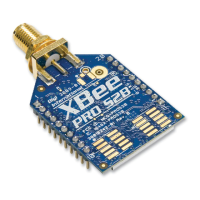Transmission, addressing, and routing RF packet routing
XBee/XBee-PRO ZigBee RF Modules User Guide 65
Acquiring source routes
Acquiring source routes requires the remote devices to send a unicast to a data collector (device that sends
many-to-one route request broadcasts). There are several ways to force remotes to send route record
transmissions.
1 If the application on remote devices periodically sends data to the data collector, each transmission will force
a route record to occur.
2 The data collector can issue a network discovery command (ND command) to force all XBee devices to send a
network discovery response. Each network discovery response will be prefaced by a route record.
3 Periodic IO sampling can be enabled on remotes to force them to send data at a regular rate. Each IO sample
would be prefaced by a route record. See Analog and digital IO lines on page 102 for details.
4 If the NI string of the remote device is known, the DN command can be issued with the NI string of the remote
in the payload. The remote device with a matching NI string would send a route record and a DN response.
Storing source routes
When a data collector receives a route record, it sends it out the UART as a Route Record Indicator API frame
(0xA1). To use source routing, the application should receive these frames and store the source route
information.
Sending a source routed transmission
To send a source routed transmission, the application should send a Create Source Route API frame (0x21) to the
XBee to create a source route in its internal source route table. After sending the Create Source Route API frame,
the application can send data transmission or remote command request frames as needed to the same
destination, or any destination in the source route. Once data must be sent to a new destination (a destination
not included in the last source route), the application should first send a new Create Source Route API frame. The
XBee can buffer one source route that includes up to 10 hops (excluding source and destination).
For example, suppose a network exists with a coordinator and five routers (R1, R2, R3, R4, R5) with known source
routes as shown below.
To send a source-routed packet to R3, the application must send a Create Source Route API frame (0x21) to the
XBee, with a destination of R3, and 2 hops (R1 and R2). If the 64- bit address of R3 is 0x0013A200 404a1234 and the
16-bit addresses of R1, R2, and R3 are:

